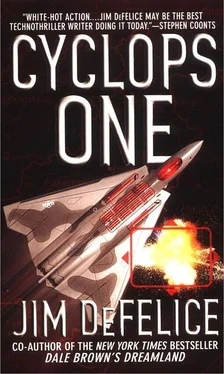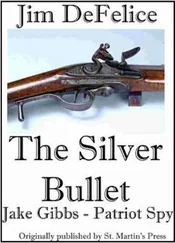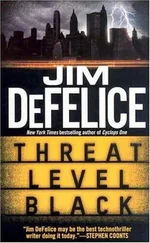That was obviously meant as a joke, since all of the Air Force people whose evaluations she could affect laughed. Klose came forward with an ultra-serious face, launching into the usual NSA bullshit about what he was going to say being “VSK”— very secret knowledge was the actual term the crypto-dweebs used at their dark castle in Maryland. VSK must not be used in any way that a normal human being might actually use it, and had to be permanently erased from the listeners’ brain cells upon the end of its period of usefulness, which by definition had already passed.
Klose then launched into a fairly technical ramble, which meandered through various alphanumerics before his tongue stumbled on the words a code variant common in high-level VPO connection communications.
“Whoa fuck,” said Kowalski with more than his usual eloquence. “You’re telling us the Russians stole the plane?”
“No. There was, uh, uh spying operation, and the transmissions came from them,” stuttered Klose amid gasps from the service people and titters from everyone else. “We’d have to decrypt the transmissions to be sure. We’re working on that. But given previous patterns, we’re reasonably sure.”
Klose rambled on about possible Russian motivations, clicking different maps and pictures onto the large screen. The spy plane’s route had been tracked: It was nearly a thousand miles away.
“It’s picking up telemetry with a towed antenna probe,” said Klose.
“Can it?” asked someone from the safety of the back row.
Klose shrugged. “Not effectively. But maybe. Definitely maybe. The capabilities—”
“So, basically, you’re just pulling our puds here,” said Fisher.
“Mister Fisher.” Gorman’s hiss was so perfectly snake-like, Fisher expected her tongue to poke him in the eyes. That hideous thought sent him back to his coffee, which, though considerably cool, was still pleasantly acidic.
Klose added a few technical details about the probable strength of the radio that had transmitted the signals, an explanation that involved sine curves and something about amplitude. The bottom line was that the Russians were probably aware that something had happened, but thus far there was no evidence that they had had anything to do with it. A thousand miles was, after all, a thousand miles.
“Fits with your stolen-plane scenario,” Kowalski told Fisher out in the hall when they broke for coffee.
“Nah,” said Fisher.
“The Dragon Lady thinks so,” said Kowalski. “Didn’t you see her eyes glowing when Klose started talking about the intercepts?”
“What Dragon Lady?” said Jemma, coming up behind them.
“Colonel Gorman,” said Kowalski, “I think you mis-heard.”
“I’m sure I didn’t.” Her glare drove the DIA agent away. “Andy, if we start looking in those lakes, can you head the team?” she asked.
“What lakes?”
“Bonham is pushing the theory that the plane is in one of the lakes. He wants to start close to the base, then work north.”
“He’s in charge?” said Fisher.
After he got the frown he expected, he added, “How does it fit with the Russian theory?”
“What Russian theory?”
“Klose’s.”
“That wasn’t a theory,” said Gorman. “The Russians were monitoring the flight. It’s just information.”
“You think they caused the malfunction?” asked Fisher.
The idea actually seemed not to have occurred to her. “I don’t know.”
“Well, I don’t think so,” Fisher said.
“Andy, don’t do that.”
“What?”
“You float out an idea and then clam up. I can’t tell if it’s serious or not.”
Fisher shrugged. “Neither can I.”
Howe applied full military power, rocking the F/A-22V upward as the first phase of the check flight was completed. The readouts were green and glowing; the engine absolutely purred and the jet seemed eager to erase any doubt that she was fit. He rode the monster thrust from the P&Ws through thirty thousand feet, roaring toward the stars with an acceleration that would have made an Atlas-series rocket envious. He started to level off as the HUD laddered through 35,000, still burning a healthy share of dinosaurs and still nailing every indicator to its sweet spot.
The techies on the ground gave him a verbal thumbsup as the Velociraptor’s thick shark’s skin brushed off a stream of turbulence at 43,000 feet. Howe slid into an orbit over the Montana wilderness, keeping the base in the center of his circle. Sweeping his eyes across the multiuse displays that flanked his tactical screen, he carefully examined each digit.
There were now about a dozen theories for the flakeout. Most involved some as yet unexplained energy spike through the shared radar-avionics system that somehow took out the main flight computers. But no simulation had been able to duplicate the problem.
Strip away the high-tech jargon and arcane formulas, and what the eggheads were saying came down to: Damned if I know.
Howe’s own opinion was that something in the telemetry exchange unit freaked out when the Cyclops weapon cycled up. The engineers, of course, said this was impossible — but they would find out for sure in a few minutes, when they cycled up the unit in Cyclops Two, sitting safely on the ground on the ramp in front of its bunker.
Howe pushed his head down, stretching the muscles in his upper back. His right shoulder had started to cramp; he could use a good back rub.
Megan’s fingers, sliding across his shoulder blade, diving into the pressure points.
“Bird Dog One, you’re looking good,” said Robert Jerome. The Air Force major was in the knockdown tower, monitoring the test flight visually, while most of the technical people were in the bunker control room. “You still got your chops, Rock.”
“Roger that,” replied Howe. Few people used his old nickname, but Jerome had flown with Howe early in his career; they’d even teamed up in a Strike Eagle squadron over Iraq.
Like many call signs, “Rock” had not initially been a compliment. It came from one of his early flight instructors, who’d described his maneuvers during a flight and what they had done to the plane’s flying characteristics. Inevitably, it stuck with his mates, but had gradually become something of an honorific.
The mission boss gave him his new course heading and altitude, duplicating the leg of the Cyclops test where the problem had occurred. Howe’s shoulder spasmed; he pushed his head around slowly, trying to relieve it, mad at his body for tensing up. He hit his marks perfectly, but the knot in his shoulder had grown to the size of a boulder, and his hands were wet and jittering.
He was nervous — beyond nervous. He was having trouble breathing right.
Howe had flown over two dozen combat missions, shot down two planes and had a hand in a third, and this had never happened to him. But those engagements had been so quick, almost literally bang-bang, that he hadn’t had time to think.
Now thinking was all he could do.
“Not a peep of a problem,” said Jerome. He sounded a little disappointed.
“Yeah, roger that.”
“All right, we want to go around again. Use the synthetic view hologram this time,” said Matt Firenze, one of the scientists in the control room. He was asking Howe to switch the HUD into the synthesized view so they could run an additional suite of tests.
Howe traded some data verbally with the ground people, duping what the sensors were telling them as he pulled the big aircraft back around. One of the women on the ground somehow reminded him of his ex-wife, Carmen, with her sharp rasp. He thought of her now, her pouty frown, her cigarette hanging out of her mouth in the hotel room they’d had their honeymoon down in New Orleans.
Читать дальше












